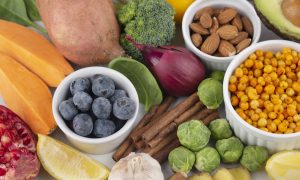By Emily C. Harrison, MS, RD, LD of Centre for Dance Nutrition.
www.dancernutrition.com.
Choosing the right energy foods doesn’t have to be complicated. It just takes knowing a few key things about how nutrients work in the body and which foods are good sources of those nutrients.
Carbohydrates are known to be an energy storehouse for athletes, but certain vitamins and minerals play an equally important role in helping us feel energetic. The important thing to remember is that real energy comes from food. “Energy” pills or supplements claims haven’t stood up to scientific study when compared to actual food. “Energy” drinks rely on extreme amounts of caffeine which does increase alertness but isn’t a substitute for real food. Lastly the body prefers to use protein for important biological functions instead of burning it for energy. A protein shake before exercise won’t give you the same energetic feeling that carbohydrates will.
Repeat after me, carbohydrates are good….
Ignore the latest anti-grain food fad and choose diverse sources of whole grains for maximum energy. Whole grains differ from refined grains because they haven’t been stripped of the nutrient rich outer bran and germ. These contain fiber, minerals, vitamin E and B-vitamins. B-vitamins help the body convert calories into useable energy. Again and again whole grains are shown to increase athletic performance and contribute to lowered risk for heart disease and type 2 diabetes1,2. Whole wheat, brown rice and oats are classics. However, think outside the box with these ancient grains:
- Barley was once the food of the Roman gladiators1. A good source of fiber, selenium and b-vitamins, it works well in soups and pilafs.
- Millet has been cultivated for 8,000 years and is a staple food in many countries1. Not only a good source of carbs and fiber, it contains the minerals manganese and phosphorus, which are important in bone health.
- Buckwheat makes for delicious noodles and is gluten free.
- Spelt is another ancient grain that has higher protein content than wheat. It does contain gluten but might be less reactive in those with mild wheat sensitivities. It can be used in breads, pancakes and baked goods and has fiber, iron, zinc, magnesium and phosphorus2.
- Quinoa cooks faster than rice, is a good source of protein, and is gluten free.
- Couscous will cook in only five minutes and is perfect when you are short on time.
Quick Burst Energy vs. Long Sustained Energy
The Glycemic Index is a tool that gives a numerical value to a specific amount of food based on how it affects your body’s blood sugar and insulin over a specific time period. Foods with lower numbers provide energy over a longer time. Whole grains, vegetables and other low glycemic index foods will help give you sustained energy, but sometimes you want to grab something for quick, immediate energy during an intermission or a short break. In this case, protein or dairy isn’t what you want. Choose simple carbs from fresh grapes, strawberries, dried fruit, pretzels, oatbars, bread and preserves, or crackers. These get absorbed and used-up fast without leaving you feeling sluggish.
Non-grain food superstars for energy and wellness
- Mushrooms: Find ones treated with UV light in the produce refrigerated section of your grocery. The UV light increases the amount of vitamin D with one serving containing more than half your recommended vitamin D for the whole day. Vitamin D isn’t just important for bone heath, it is critical in immune function and disease prevention. You can’t feel energetic if you are sick. People with normal Vitamin D status in their body can fight infections better than those who are deficient.
- Sweet potatoes: Contain Vitamin C and the antioxidants beta-carotene and Lutein. Lutein is an antioxidant whose protective effect may increase when heated2. Sweet potatoes’ glycemic index score is 41 points better than a standard white russet potato3.
- Beans, lentils, and peas: Only one half cup of these nutrient powerhouses have 23 grams of carbohydrate but they also have a full serving of protein too4. Plus they have iron and zinc, which are important in fighting illness. And, you can’t beat the price at $0.25/ serving.
For more information on nutrition and maintaining more energy, check out my other Dance Informa articles on this topic: Don’t Fear Carbs, Glycemic Index, Energy Balance and Protein Needs of Dancers.
Emily Harrison
 Emily Cook Harrison MS, RD, LD
Emily Cook Harrison MS, RD, LD
Emily is a registered dietitian and holds both a bachelor’s and master’s degree in nutrition from Georgia State University. Her master’s thesis research was on elite level ballet dancers and nutrition and she has experience providing nutrition services for weight management, sports nutrition, disordered eating, disease prevention, and food allergies. Emily was a professional dancer for eleven years with the Atlanta Ballet and several other companies. She is a dance educator and the mother of two young children. She now runs the Centre for Dance Nutrition and Healthy Lifestyles. She can be reached at emily@dancernutrition.com www.dancernutrition.com
Sources:
1. Mateljan, G. The World’s Healthiest Foods. 2007
2. Environmental Nutrition Newsletter of Food, Nutrition & Health. Vol 36, issue 11. November 2013. www.environmentalnutrition.com
3. Glycemic Index and Glycmic Load for 100 foods. 2013 www.health.harvard.edu/newsweek/Glycemic_index_and_glycemic_load_for_100_foods.htm
4. USDA Database for Standard Reference. 2013
Photo (top): © Piotr Marcinski | Dreamstime.com















